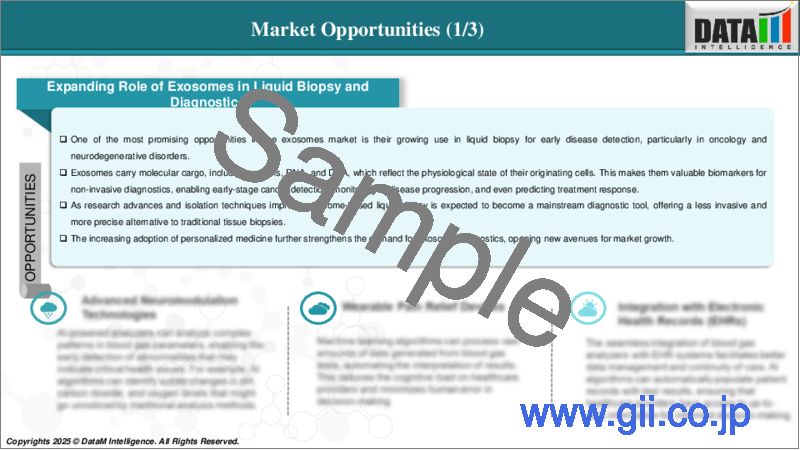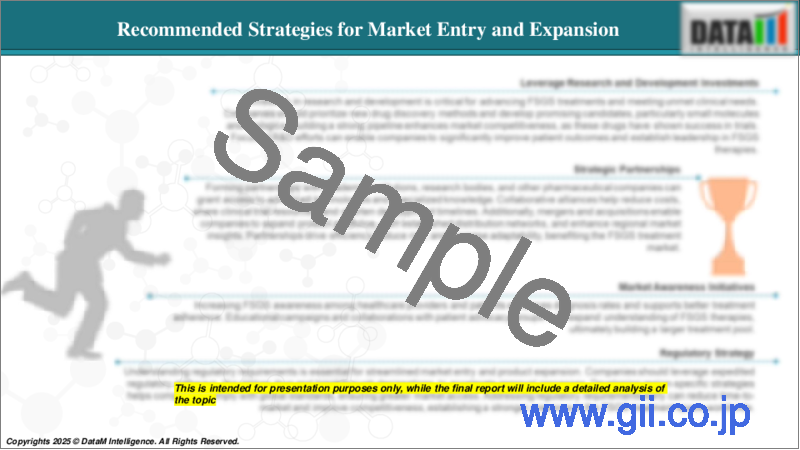|
|
市場調査レポート
商品コード
1560844
エクソソームの世界市場:2024年~2031年Global Exosomes Market - 2024 - 2031 |
||||||
カスタマイズ可能
適宜更新あり
|
|||||||
| エクソソームの世界市場:2024年~2031年 |
|
出版日: 2024年09月23日
発行: DataM Intelligence
ページ情報: 英文 186 Pages
納期: 即日から翌営業日
|
- 全表示
- 概要
- 目次
レポート概要
世界のエクソソーム市場は2023年に13億米ドルに達し、2031年には27億米ドルに達する見込みで、予測期間2024-2031年のCAGRで15.6%の成長が予測されています。
エクソソームは30~200nmの小胞で、腫瘍壊死因子(TNF)に誘導された間葉系幹細胞(TME)のシグナル伝達を媒介するために細胞から分泌されます。がん原性EGFRは細胞から排出され、他のTME細胞と相互作用することができます。胃がん細胞からのエクソソームは、肝微小環境を制御し、肝転移を促進する可能性があります。EGFRを含むエクソソームは内皮細胞に捕捉され、EGFR依存的な応答とVEGF分泌を引き起こします。EGFR変異NSCLCからのエクソソームはCD8+T細胞のアポトーシスを促進し、免疫療法の有効性に影響を及ぼす可能性があります。
市場力学:
促進要因と抑制要因
がん有病率の上昇。
がん罹患率の増加により、革新的な治療法に対する需要が高まっています。血液、尿、唾液などの体液中のバイオマーカーを分析するために、リキッドバイオプシーなどのエクソソームベースの技術が利用されています。エクソソームは分子情報の安定した運搬体として、リキッドバイオプシーアプローチの理想的な候補です。研究者たちは、エクソソームバイオマーカーを病気の進行、治療効果、微小残存病変の検出に利用することを模索しています。
例えば、National Center for Health Statisticsによると、2023年には米国で195万8,310人の新規がん罹患者と60万9,820人のがん死亡者が発生すると予測されています。前立腺がんの罹患率は、20年間の減少の後、2014年から2019年にかけて毎年3%ずつ増加し、99,000人の新規症例が追加されることになります。しかし、それ以外の点では、罹患動向は女性に比べて男性の方が良好でした。
エクソソーム単離の技術的複雑性と技術的限界
エクソソームは、その大きさ、組成、積荷によって特徴づけられるため、高純度かつ特異的に単離することが技術的課題となります。標準化された方法がないため、実験結果にばらつきが生じ、研究間の比較可能性が妨げられます。他の細胞外小胞や汚染物質が存在するため、単離プロセスは技術的に困難です。純粋で高収率のエクソソーム単離を行うには高度な技術が必要であり、得られたサンプルの品質と一貫性に影響を及ぼす可能性があります。
市場セグメンテーション
世界のエクソソーム市場は、製品タイプ、用途、エンドユーザー、地域によって区分されます。
製品タイプ別では、キット・試薬がエクソソーム市場シェアの約47.3%を占めています。
製品タイプ別では、キット・試薬が約47.3%を占めています。キットおよび試薬は、エクソソームの研究や臨床応用に不可欠なツールです。血液、尿、細胞培養液のような生体試料からのエクソソームの単離、検出、分析を容易にします。これらのツールは、生物学的完全性を保ちながら、高い収量と純度を保証します。キットは単離プロセスを簡素化し、技術的専門知識の乏しい人でも利用できるようにします。抗体や色素のような試薬は、エクソソーム表面マーカーを標識・検出し、エクソソームカーゴの特性解析を可能にします。これは診断、特にがん、神経変性疾患、心血管疾患などのバイオマーカーの同定に極めて重要です。
例えば、2023年7月に島津製作所が開発したExorapid-qICは、大日本図書株式会社が発売した細胞外小胞(CD9)用のイムノクロマトグラフィーキットで、エクソソームをターゲットとした世界初のキットです。本キットには、金ナノプレート標識抗体、イムノクロマト試験紙、リンス液が含まれます。島津製作所は、EVの種類の検出と検出システムの最適化を担当しています。
地域別の市場分析
北米は予測期間を通じて市場シェア全体の約38.4%を占めると予測されます。
北米は、新しいバイオマーカー検出のための政府助成金の増加、心血管疾患やがんなどの慢性疾患の発生率の増加により、予測期間を通じて市場全体の約38.4%のシェアを占めると推定・予測されます。また、新薬、診断法、治療法の開発のための研究開発活動の活発化が、同分野の成長を促進すると予測されています。
例えば、2024年7月、神経エクソソームに基づく神経変性疾患治療薬のリーダーであるアルナ・バイオ社は、神経幹細胞由来のエクソソームであるリードプログラムAB126の米国特許第11,993,787号を取得しました。この特許は、AB126の物質組成とAB16を使用した遺伝子治療のための製品をカバーする保護を拡大するもので、2038年までに付与される予定です。
目次
第1章 調査手法と調査範囲
第2章 定義と概要
第3章 エグゼクティブサマリー
第4章 市場力学
- 影響要因
- 促進要因
- がんの有病率の上昇
- 個別化医療への注目の高まり
- 抑制要因
- エクソソーム分離の技術的複雑さと技術的限界
- 機会
- 影響分析
- 促進要因
第5章 産業分析
- ポーターのファイブフォース分析
- サプライチェーン分析
- 価格分析
- 規制分析
- 特許分析
- PESTLE分析
- SWOT分析
- DMIオピニオン
第6章 製品タイプ別
- キット・試薬
- 機器
- その他
第7章 用途別
- がん
- 非がん
第8章 エンドユーザー別
- 診断
- 病院・臨床検査機関
- その他
第9章 地域別
- 北米
- 米国
- カナダ
- メキシコ
- 欧州
- ドイツ
- 英国
- フランス
- イタリア
- スペイン
- その他欧州
- 南米
- ブラジル
- アルゼンチン
- その他南米
- アジア太平洋
- 中国
- インド
- 日本
- 韓国
- その他アジア太平洋地域
- 中東・アフリカ
第10章 競合情勢
- 競合シナリオ
- 市況/シェア分析
- M&A分析
第11章 企業プロファイル
- STARTEK Health
- 会社概要
- 製品ポートフォリオと説明
- 財務概要
- 主な発展
- Diagenode Inc
- Fujifilm Holdings Corporation
- Hitachi Chemical Diagnostics Inc
- Lonza
- MBL International
- Miltenyi Biotec
- Novus Biologicals
- Qiagen
- Thermo Fisher Scientific Inc
第12章 付録
Report Overview
Global Exosomes Market reached US$ 1.3 billion in 2023 and is expected to reach US$ 2.7 billion by 2031, growing at a CAGR of 15.6% during the forecast period 2024-2031
Exosomes, small vesicles 30 to 200 nm, are secreted from cells to mediate signaling in the tumor necrosis factor (TNF)-induced mesenchymal stem cells (TME). Oncogenic EGFR can be shed from cells and interact with other TME cells. Exosomes from gastric cancer cells can regulate the liver microenvironment and promote liver metastasis. EGFR-containing exosomes can be captured by endothelial cells, eliciting EGFR-dependent responses and VEGF secretion. Exosomes from EGFR-mutated NSCLC can promote CD8+ T cell apoptosis, potentially affecting immunotherapy efficacy.
Market Dynamics: Drivers & Restraints
Rise in the prevalence of cancers.
The increasing prevalence of cancer has led to a growing demand for innovative therapies. Exosome-based technologies, such as liquid biopsy, are being used to analyze biomarkers in bodily fluids like blood, urine, or saliva. Exosomes, as stable carriers of molecular information, are ideal candidates for liquid biopsy approaches. Researchers are exploring the use of exosomal biomarkers for disease progression, treatment response, and detecting minimal residual disease.
For instance, according to the National Center for Health Statistics, In 2023, 1,958,310 new cancer cases and 609,820 cancer deaths are projected to occur in the United States. Cancer incidence increased for prostate cancer by 3% annually from 2014 through 2019 after two decades of decline, translating to an additional 99,000 new cases; otherwise, however, incidence trends were more favorable in men compared to women.
Technical complexity of exosome isolation and technological limitations
Exosomes, characterized by their size, composition, and cargo, present a technical challenge in isolating them with high purity and specificity. The absence of standardized methods can lead to variability in experimental outcomes and hinder comparability between studies. The isolation process is technically demanding due to the presence of other extracellular vesicles and contaminants. Obtaining pure and high-yield exosome isolation requires sophisticated techniques, which can affect the quality and consistency of the obtained samples.
Market Segment Analysis
The global exosomes market is segmented based on product type, application, end-user, and region.
The kits and reagents from the product type segment accounted for approximately 47.3% of the exosomes market share
The kits and reagents from the product type segment accounted for approximately 47.3%. Kits and reagents are essential tools in exosome research and clinical applications. They facilitate the isolation, detection, and analysis of exosomes from biological samples like blood, urine, and cell culture media. These tools ensure high yield and purity while preserving biological integrity. Kits simplify the isolating process, making it accessible to those with limited technical expertise. Reagents, like antibodies and dyes, label and detect exosomal surface markers, enabling the characterization of exosome cargo. This is crucial for diagnostics, particularly in identifying biomarkers for diseases like cancer, neurodegenerative disorders, and cardiovascular conditions.
For instance, in July 2023, Shimadzu Corporation developed Exorapid-qIC, an immunochromatography kit for extracellular vesicles (CD9) launched by Dai Nippon Toryo Co., Ltd., it is the world's first kit targeting exosomes. The kit includes gold nanoplate-labeled antibodies, immunochromatography test paper, and rinse solution. Shimadzu is responsible for detecting EV types and optimizing the detection system.
Market Geographical Analysis
North America is estimated to hold about 38.4% of the total market share throughout the forecast period
North America is estimated to hold about 38.4% of the total market share throughout the forecast period due to the rising government funding for the detection of new biomarkers and the increasing incidence of chronic conditions, such as cardiovascular diseases and cancer. In addition, growing research & development activities for the development of novel drugs, diagnostic methods, and treatment options are anticipated to drive the segment growth.
For instance, in July 2024, Aruna Bio, a leader in neural exosome-based therapeutics for neurodegenerative conditions, received a US Patent No. 11,993,787 for its lead program, AB126, an exosome derived from neural stem cells. The patent, which extends protection covering the composition of matter for AB126 and products for gene therapy using AB16, is expected to be granted by 2038.
Market Segmentation
By Product Type
Kits and Reagents
Instruments
Others
By Application
Cancer Applications
Lung Cancer
Breast Cancer
Prostate Cancer
Colorectal Cancer
Other
Non-Cancer Applications
By End User
Diagnostics
Hospitals & Clinical Testing Laboratories
Others
By Region
North America
U.S.
Canada
Mexico
Europe
Germany
UK
France
Italy
Spain
Rest of Europe
South America
Brazil
Argentina
Rest of South America
Asia-Pacific
China
India
Japan
South Korea
Rest of Asia-Pacific
Middle East and Africa
Market Competitive Landscape
The major global players in the market include STARTEK Health, Diagenode Inc., Fujifilm Holdings Corporation, Hitachi Chemical Diagnostics Inc., Lonza, MBL International, Miltenyi Biotec, Novus Biologicals, Qiagen, Thermo Fisher Scientific Inc. among others.
Key Developments
In January 2024, EXO Biologics SA, a Belgian biotech company committed to developing biopharmaceuticals using exosomes to treat rare diseases with high unmet medical needs, launched ExoXpert, a contract development and manufacturing organization (CDMO) specializing in exosomes. ExoXpert offers an MSC-based exosome manufacturing platform used in European clinical trials and is a wholly-owned subsidiary of EXO Biologics.
Why Purchase the Report?
To visualize the global exosomes market segmentation based on product type, application, end-user, and region as well as understand key commercial assets and players.
Identify commercial opportunities by analyzing trends and co-development.
Excel data sheet with numerous data points of the exosomes market level with all segments.
PDF report consists of a comprehensive analysis after exhaustive qualitative interviews and an in-depth study.
Product mapping available as excel consisting of key products of all the major players.
The global exosomes market report would provide approximately 64 tables, 61 figures, and 186 pages.
Target Audience 2024
Manufacturers/ Buyers
Industry Investors/Investment Bankers
Research Professionals
Emerging Companies
Table of Contents
1. Methodology and Scope
- 1.1. Research Methodology
- 1.2. Research Objective and Scope of the Report
2. Definition and Overview
3. Executive Summary
- 3.1. Snippet by Product Type
- 3.2. Snippet by Application
- 3.3. Snippet by End User
- 3.4. Snippet by Region
4. Dynamics
- 4.1. Impacting Factors
- 4.1.1. Drivers
- 4.1.1.1. Rise in the prevalence of cancer
- 4.1.1.2. Increasing focus on personalized medicine
- 4.1.2. Restraints
- 4.1.2.1. Technical complexity of exosome isolation and technological limitations
- 4.1.3. Opportunity
- 4.1.4. Impact Analysis
- 4.1.1. Drivers
5. Industry Analysis
- 5.1. Porter's Five Force Analysis
- 5.2. Supply Chain Analysis
- 5.3. Pricing Analysis
- 5.4. Regulatory Analysis
- 5.5. Patent Analysis
- 5.6. PESTLE Analysis
- 5.7. SWOT Analysis
- 5.8. DMI Opinion
6. By Product Type
- 6.1. Introduction
- 6.1.1. Market Size Analysis and Y-o-Y Growth Analysis (%), By Product Type
- 6.1.2. Market Attractiveness Index, By Product Type
- 6.2. Kits and Reagents*
- 6.2.1. Introduction
- 6.3. Instruments
- 6.4. Others
7. By Application
- 7.1. Introduction
- 7.1.1. Market Size Analysis and Y-o-Y Growth Analysis (%), By Application
- 7.2. Market Attractiveness Index, By Application
- 7.3. Cancer Applications*
- 7.3.1. Introduction
- 7.3.2. Market Size Analysis and Y-o-Y Growth Analysis (%)
- 7.4. Non-Cancer Applications
8. By End User
- 8.1. Introduction
- 8.1.1. Market Size Analysis and Y-o-Y Growth Analysis (%), By End User
- 8.1.2. Market Attractiveness Index, By End User
- 8.2. Diagnostics*
- 8.2.1. Introduction
- 8.2.2. Market Size Analysis and Y-o-Y Growth Analysis (%)
- 8.3. Hospitals & Clinical Testing Laboratories
- 8.4. Others
9. By Region
- 9.1. Introduction
- 9.1.1. Market Size Analysis and Y-o-Y Growth Analysis (%), By Region
- 9.1.2. Market Attractiveness Index, By Region
- 9.2. North America
- 9.2.1. Introduction
- 9.2.2. Key Region-Specific Dynamics
- 9.2.3. Market Size Analysis and Y-o-Y Growth Analysis (%), By Product Type
- 9.2.4. Market Size Analysis and Y-o-Y Growth Analysis (%), By Application
- 9.2.5. Market Size Analysis and Y-o-Y Growth Analysis (%), By End User
- 9.2.6. Market Size Analysis and Y-o-Y Growth Analysis (%), By Country
- 9.2.6.1. U.S.
- 9.2.6.2. Canada
- 9.2.6.3. Mexico
- 9.3. Europe
- 9.3.1. Introduction
- 9.3.2. Key Region-Specific Dynamics
- 9.3.3. Market Size Analysis and Y-o-Y Growth Analysis (%), By Product Type
- 9.3.4. Market Size Analysis and Y-o-Y Growth Analysis (%), By Application
- 9.3.5. Market Size Analysis and Y-o-Y Growth Analysis (%), By End User
- 9.3.6. Market Size Analysis and Y-o-Y Growth Analysis (%), By Country
- 9.3.6.1. Germany
- 9.3.6.2. UK
- 9.3.6.3. France
- 9.3.6.4. Italy
- 9.3.6.5. Spain
- 9.3.6.6. Rest of Europe
- 9.4. South America
- 9.4.1. Introduction
- 9.4.2. Key Region-Specific Dynamics
- 9.4.3. Market Size Analysis and Y-o-Y Growth Analysis (%), By Product Type
- 9.4.4. Market Size Analysis and Y-o-Y Growth Analysis (%), By Application
- 9.4.5. Market Size Analysis and Y-o-Y Growth Analysis (%), By End User
- 9.4.6. Market Size Analysis and Y-o-Y Growth Analysis (%), By Country
- 9.4.6.1. Brazil
- 9.4.6.2. Argentina
- 9.4.6.3. Rest of South America
- 9.5. Asia-Pacific
- 9.5.1. Introduction
- 9.5.2. Key Region-Specific Dynamics
- 9.5.3. Market Size Analysis and Y-o-Y Growth Analysis (%), By Product Type
- 9.5.4. Market Size Analysis and Y-o-Y Growth Analysis (%), By Application
- 9.5.5. Market Size Analysis and Y-o-Y Growth Analysis (%), By End User
- 9.5.6. Market Size Analysis and Y-o-Y Growth Analysis (%), By Country
- 9.5.6.1. China
- 9.5.6.2. India
- 9.5.6.3. Japan
- 9.5.6.4. South Korea
- 9.5.6.5. Rest of Asia-Pacific
- 9.6. Middle East and Africa
- 9.6.1. Introduction
- 9.6.2. Key Region-Specific Dynamics
- 9.6.3. Market Size Analysis and Y-o-Y Growth Analysis (%), By Product Type
- 9.6.4. Market Size Analysis and Y-o-Y Growth Analysis (%), By Application
- 9.6.5. Market Size Analysis and Y-o-Y Growth Analysis (%), By End User
10. Competitive Landscape
- 10.1. Competitive Scenario
- 10.2. Market Positioning/Share Analysis
- 10.3. Mergers and Acquisitions Analysis
11. Company Profiles
- 11.1. STARTEK Health*
- 11.1.1. Company Overview
- 11.1.2. Product Portfolio and Description
- 11.1.3. Financial Overview
- 11.1.4. Key Developments
- 11.2. Diagenode Inc
- 11.3. Fujifilm Holdings Corporation
- 11.4. Hitachi Chemical Diagnostics Inc
- 11.5. Lonza
- 11.6. MBL International
- 11.7. Miltenyi Biotec
- 11.8. Novus Biologicals
- 11.9. Qiagen
- 11.10. Thermo Fisher Scientific Inc (*LIST NOT EXHAUSTIVE)
12. Appendix
- 12.1. About Us and Services
- 12.2. Contact Us






